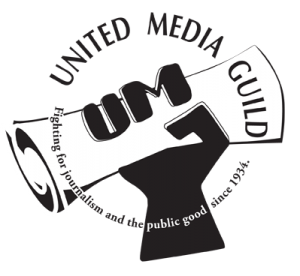The United Media Guild turned 80 this year.
It formed as the St. Louis Newspaper Guild in January, 1934, joining a national movement to unionize newsroom and commercial operations employees. It began with 50 members from the St. Louis Post-Dispatch and Associated Press, but immediately branched out to the other newspapers in town.
By the next month, the local included employees at the Globe-Democrat and Star-Times as well. It adopted a constitution and by-laws and affiliated with the American Newspaper Guild — now known as The Newspaper Guild, a sector with the Communications Workers of America.
We have tentatively scheduled an 80th anniversary party for June 1 at Creve Coeur Park. This event will be for all active members as well as all those Guild retirees and alumni that helped us maintain our strength over the years.
We will post more information on that event once we confirm all the details.
From Day 1, our local has played a vital role in protecting the quality of journalism and journalism jobs in this region.
At the initial St. Louis Newspaper Guild meeting, members elected Thomas B. Sherman as chairman, H.E. Douglass as secretary-treasurer and E. Roy Alexander, Joseph Hanlon and J. Roy Stockton as members of the executive committee.
The next month the expanded local adopted its constitution and by-laws. Members elected Post-Dispatch political writer Curtis A. Bettis as its first president. David Brown of the Globe-Democrat was elected vice president and William F. Gould of the Star-Times became secretary.
In 1937, the Star-Times signed a “closed shop” agreement requiring all employees to become members of the Guild. Minimum wages ranged from $20 per week for beginners to $50 per week for those with five years experience.
In 1938, the Post-Dispatch unit signed a hallmark 18-month contract that established the best four-year minimum scales in the country. Reporters made at least $30 a week for the first year, $40 for the second year, $45 for the third year and $50 for the fourth year.
In 1941, Globe-Democrat employees agreed to a new contract – and the first agreement to cover editorial employees in addition to members of six commercial departments. It set new wage minimums of $50 for reporters, copyreaders and artists with five years experience.
There have been many memorable labor battles along the way. The Post-Dispatch ceased publication during strikes in 1945, 1973 and 1978-79. After the Guild’s strike in 1959 at the Globe-Democrat, that newspaper sold its building and presses to the Post-Dispatch.
The St. Louis Newspaper Guild changed its named to United Media Guild after merging with the Peoria Newspaper Guild. Currently the UMG represents employees of the Post-Dispatch, the St. Louis Labor Tribune, the St. Louis Review, KSDK-TV, the Peoria Journal Star, the Pekin Daily Times, the State Journal-Register in Springfield, the Rockford Register Star and the Freeport Journal-Standard.
We also represent workers at Missouri Jobs with Justice, the St. Louis Organizing Committee, Unicom ARC and the Workers Interfaith Network in Memphis.
It is impossible to list all the great activists who followed these pioneers, but Harper Barnes and Fred Faust were instrumental in operating strike newspapers in the 1970s.
Legendary critic Joe Pollock and veteran news reporter Tim O’Neil are two contemporary examples of journalists that worked tirelessly on behalf of their co-workers while serving as local president.
